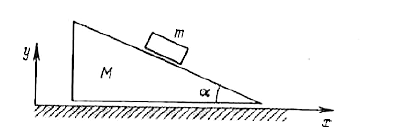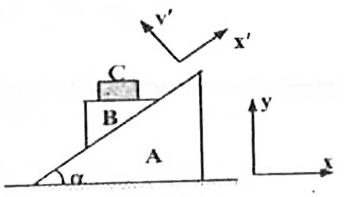Find the acceleration of each block in the figure shown below, in terms of their masses m1,m2 and g. Neglect any friction.

Let T be the tension in the string that is assumed to be massless.
For mass m1, the FBD shows that N1=m1g
Where N1 is the force applied upward by plane on the mass m1 .If acceleration of m1along horizontal is a1, then T=m1a1 ......(i)

For mass m2, the FBD shows that
m2g−2T=m2a2 ...(ii)
Where a2 is vertical acceleration of mass m2.
Note that upward tension on m2 is 2T applied.

by both sides of the string from constrain relation
a2=a12
Thus, the acceleration of m1 its twice that m2. with this input, solving (i) and (ii) we find
a1=2m2g4m1+m2
a2=m2g4m1+m2
Topper's Solved these Questions
- NLM & FRICTIONBOOK - MOTIONCHAPTER - NLM & FRICTIONEXERCISE - SOLVED EXAMPLE
16 Videos
- NLM & FRICTIONBOOK - MOTIONCHAPTER - NLM & FRICTIONEXERCISE - EXERCIS-1
80 Videos
- NLM & FRICTIONBOOK - MOTIONCHAPTER - NLM & FRICTIONEXERCISE - EXERCISE-4 ( LEVEL-II)
15 Videos
- NEWTON'S LAWS OF MOTION & FRICTION BOOK - MOTIONCHAPTER - NEWTON'S LAWS OF MOTION & FRICTION EXERCISE - Exercise - 3 Section-B
12 Videos
- ONE DIMENSION MOTIONBOOK - MOTIONCHAPTER - ONE DIMENSION MOTIONEXERCISE - Exercise - 3 |Section - B Previous Year Problems | JEE MAIN
12 Videos
Similar Questions
A block of mass m is placed on wedge of mass M (Fig.). Find the accelerations of the block and the wedge in the reference system fixed to the table, and the reaction. Friction is to be neglected.
Analyse the limiting case when the wedge remains stationary.

View SolutionFigure shows a block of mass m1 sliding on a block of mass m2, with m1>m2. Find the

(a) acceleration of each block
(b) tension in the string
(c ) force exerted by m1 on m2. ltbr> (d) force exerted by m2 on the incline.
View SolutionFind the acceleration of the block of mass m in the arrangement shown in the following figures. The masses of the pulleys and the threads, as well as the friction are assumed to be negligible.

View Solution(a) shows a block of mass m1 sliding on a block of mass m2, with m1>m2. Find
(a) the acceleration of each block,
(b) tension in the string,
(c) force exerted by m1 on m2
(d) force exerted by m2 on the incline

View SolutionIn the arrangement shown, find the acceleration of each block, tension in the string and reaction in the pulley. The string and pulley are light (massless) (m1>m2). Neglect the friction in pulley.

View SolutionIn the figure shown, find out acceleration of each block.

View SolutionFind the acceleration of the block of mass M in the situation shown in figure. All the surfaces are frictionless.

View SolutionIn the shown figure, the wedge A is fixed to the ground. The prism B of mass M and the block C of mass m is placed as shown. Find the acceleration of the block C w.r.t. B when the system is set free. Neglect any friction.

View SolutionFind the acceleration of the prism of mass M and that of the bar of mass m shown in figure.

View SolutionA block of mass m1 on a smooth, horizontal· swface is: connected to a second mass m2 by a light cord ovbr a light,: frictionless pulley as shown. (Neglect the mass of the cord and' of the pulley). A force of magnitude F0 is applied to mass m1· as shown. Neglect any friction.

(a) Find the value of force F0 for which the sy!tem will be in equilibrium.
(b) Find the acceleration of masses andtensio~ in string if F0 has a value which is double of that foun,d in part (a).
View Solution
